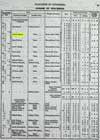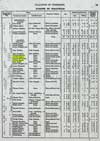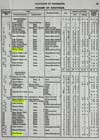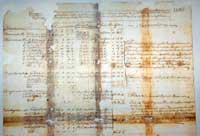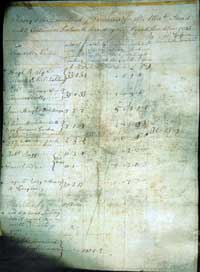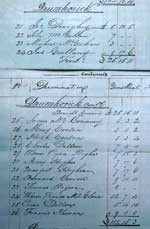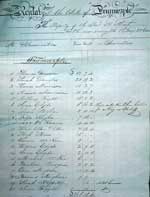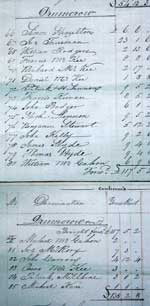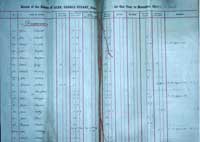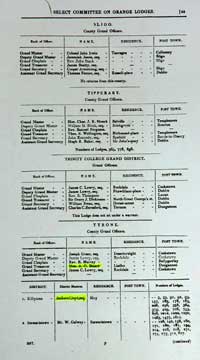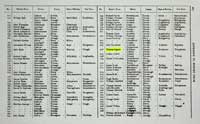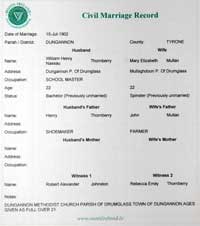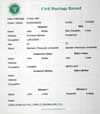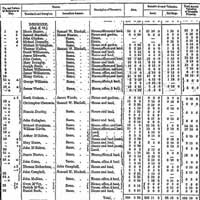This little girl is the only one of my ancestors, back to 1800, not born in south Ulster.
It brings to mind another little girl, her great-grandmother, who was born in India about 1794 and married 11 years later.
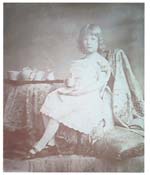
My services
Can you answer yes to any of the following questions? If so, I can help you.

Don't know who your ancestors were?
Have you been working with on-line sources and want to know more about your family's life and times?
Would you like a full genealogy report?

Do you live outside Ireland?
Do you need help in accessing specific records only available locally?
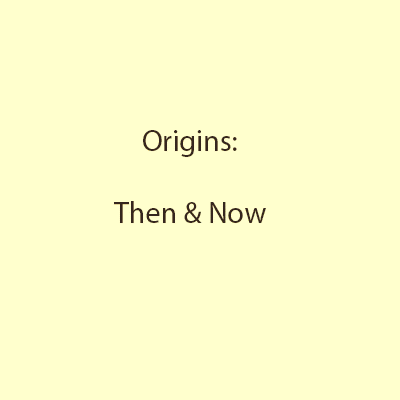
Did your ancestors emigrate from Ireland?
Do you need assistance in identifying their hometown?
What does it look like today?
Contact me for a free genealogical assessment.
Any quotes will be based on this and tailored to your budget.
Searches can be successful with minimal information but essential are:
Names of most distant ancestors
Dates of births, marriages or deaths
As much detail aspossible on place of origin or residence in Ireland (Townland, Parish, County)
Categories of research:
Full Genealogy Report Sample Genealogy Report
If you already have a comprehensive family tree you might like more information about their life and times
I can access records at General Register Office, Registery of Deeds, Gravestones or estate rent rolls etc
Using Griffith's Property Valuation I can identify your ancestral home and supply photographs of the area/house
Sample Genealogy Report
Rogers/Mullen Genealogy
My mother, Patricia Clugston, was born in Dungannon and both her parents, James Clugston and Maud Charles, were born there and lived in the town virtually all their lives. In this study I am following the genealogy of my grandmother. Maud died just before I was born so I obtained my initial information and also some family photographs from my mother and also from her cousin, Hilda Eisenbrey/Charles. While the first portion of this study does include some documentation, it is basically designed to set the scene and pose the questions to be answered.
According to my mother her grandparents were Thomas Charles, a Dungannon coal merchant, and Amelia Rogers. Thomas died in 1942, aged 84 , Amelia in 1937, aged 78 (death certificates for both under Church records) & so my mother who was born in 1919 knew them both well. This study will concentrate on Amelia and her ancestors.
The first search was for Thomas & Amelia Charles in Dungannon in the 1911 census. The attached form shows that Thomas and Amelia Charles were living in Scotch St, Dungannon with 5 children, including my grandmother, Maude. Thomas is correctly described as a coal merchant. They had been married for 25 years and 6 of their 7 children were still living. This information provided a date to search for their marriage in the General Register Office (GRO). (Click image for full sized version)
The original marriage certificate {GRO July-Sept 1885 1:903, Newry} is attached. The couple got married in Warrenpoint. For the purposes of this study the useful information provided is that the father of Amelia was James Rogers, coachman. (In passing it might be noted that the father of Thomas was Henry Charles, MD, but the implications of this are not relevant to the study; in fact Thomas was illegitimate.) (Click image for full sized version)
A search in the 1901 census was carried out for James Rogers, coachman. James Rogers, retired coachman, aged 70 was living in the townland of Stangmore (Knox) which is on the southern outskirts of Dungannon, with his wife, Mary Jane, aged 68. Both Patricia McWilliam/Clugston and Hilda Eisenbrey confirmed that Mary Jane's maiden name was Mullen and Hilda provided a photograph of her. (Click image for full version)
The death certificate of Amelia Rogers suggested that she was born around 1857/8 so the GRO was successfully searched for the marriage of James Rogers to Mary Jane Mullen between 1852 and 1856.
{GRO 1855 5:475} {James Rogers of full age, farmer, Drumhorig, father, Thomas Rogers, farmer, married Mary Jane Mullen of full age, Drumkee, father John Mullen, farmer in Killyman Parish church on 5th Jan, 1855. Both signed with their mark:
Crucially this certificate identifies townlands in Killyman parish as the places of residence of both parties to the marriage. (Click image for full version)
Description of Killyman parish
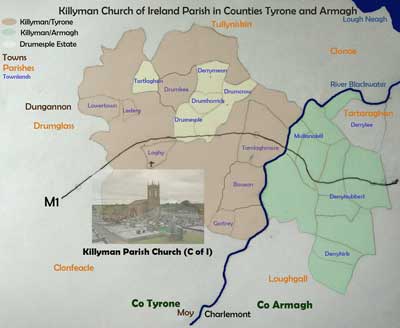
Killyman parish runs East of Dungannon town in the direction of Lough Neagh. It is partly in Co Tyrone and partly in Co Armagh, with this division being determined by the river Blackwater. It is bordered on the West by the parish of Drumglass; on the North by Tullyniskan & Clonoe; on the South by Clonfeacle & Loughgall & on the East by Tartaraghan. The map also shows the townlands mentioned in this study and in particular the townlands of the Drumesple estate as owned by the Rev Alexander G Stuart at the time of Griffith's Property Valuation in 1860.
Most of the church records examined in this study derive from Killyman parish church.
Historical context
Killyman lies within the area of Ulster which, during the eighteenth and early nineteenth centuries, was dominated by the linen industry. Because of this the region was characterized by very small farms and cottier/weaver houses, resulting in high densities of population. The area was equally split between Protestant (almost entirely Church of Ireland) & Catholic and from the 1790s competition for land and sectarian tensions became increasingly common.
In the first half of the nineteenth century the area became notorious for the activities of the Killyman Orangemen. A group of these, known as the ‘Killyman Wreckers’ or ‘Verners Wreckers’ destroyed the village of Maghery, near Lough Neagh, in 1831. They were also involved in intimidating Liberal voters in a contested Parliamentary election in Dungannon in 1841.
Killyman Parish Registers
The Killyman Church of Ireland parish church is located in the townland of Laghy. The registers on microfilm in the Public Records Office of Northern Ireland (henceforth PRONI) run from 1745 to 1875. Baptisms and Burials cover the entire period; Marriages run to 1845 when civil registration of Protestant marriages commenced. Confirmation records, which give both townland and age of the individual, exist for 1824, 1828 and at regular intervals from 1837 on. The records appear to be continuous with no obvious gaps. In general they can be readily deciphered but from about 1760 to 1778 are blackened so that while some entries can be read, a systematic search is not possible. From 1745 up to 1837 baptisms, marriages and burials are recorded as they occur. Thereafter each category is separated. Up to 1830 the records do not normally include townland information. However in the case of many baptisms, particularly in large families, the townland can be inferred from the confirmation records.
These records were investigated in a directed fashion; initially a search was conducted for the children of James and Mary Jane Rogers. This was followed by a search for the baptism of James Rogers (& his siblings) and subsequently for his father, Thomas Rogers (& his siblings) and finally for the birth of Mary Jane Mullen and any siblings. In practice entries for the Rogers and Mullen families were found throughout the registers; the earliest entry dates to 1755, the last to 1872 and ultimately the entire register was searched. Many additional entries were transcribed and can be found (in chronological order) in Church records. Entries relevant to this study are introduced as the narrative demands.
Children of James & Mary Jane Rogers
From Killyman Church of Ireland baptismal register:
Born Feb 17 1855/ Bapt 10 Dec 1855 William Jackson of James & Mary Jane Rogers, Farmer, Drumhorrig
Born 25th Nov 1858/ Bapt Nov 28th 1858 Milly of James and Mary Jane Rogers, Farmer, Mullanakill
Bapt Mar 19 1865/ Born 1864 Thomas John of James and Mary Jane Rogers, Labourer, Derryhubbart}
William Jackson, according to the family, emigrated to the US and nothing further is known about him. The family could provide no further information about Thomas. Milly is presumably my great, grandmother, Amelia. It should be remarked that while James was described as a farmer in the first two entries, by the third the description was labourer. Twenty years later on his daughter's marriage certificate he was a coachman.
Rogers Genealogy
Robert Bell: The Book of Ulster Surnames
Robert Bell in his Book of Ulster Surnames notes that while Rogers can be derived from the Christian name Roger of English & Scottish (normally Rodgers) origin, it can also represent an Anglicisation of the name McRory. He further notes that in the Dungannon area up to 1900 Rogers/Rodgers was used interchangeably with Macrory/McCrory. In this study all forms were noted.
Survey of Rogers & Macrory in Killyman & surrounding parishes:
| Parish | Rogers | Macrory |
| Clonoe | 0 | 5 |
| Tullyniskan | 0 | 2 |
| Clonfeacle | 2 | 9 |
| Drumglass | 7 | 5 |
| Killyman | 5 | 1 |
| Tartaraghan | 6 | 0 |
| Loughgall | 1 | 0 |
While censuses were taken in Ireland in the nineteenth century every ten years from 1821, the originals of those for 1861, 1871, 1881 and 1891 were completely destroyed, while only fragments of the earlier returns survive. None of these fragments cover the relevant area of Co. Tyrone.
In the absence of nineteenth century census returns, a property survey referred to as Griffith’s Primary Valuation, has taken on a significance it would not otherwise have had. It was compiled for taxation purposes and was published in stages between 1848 and 1864. The section covering the Killyman area of Co. Tyrone was published in 1860. It is now available free on-line through askaboutireland.ie.
Griffith’s Valuation was used to get an estimate of the prevalence of the Rogers/Rodgers & McCrory/Macrory surnames in Killyman and the surrounding parishes (Table 1). There were roughly equal numbers (21/22) with Rogers more common in the South & East and Macrory more common in the North & West. In Killyman there were five Rogers and one Macrory and these will be discussed later. Neither Rodgers nor McRory was observed.
Identification of baptismal records of James Rogers and his siblings
{No record of the marriage of Thomas and Millie Rogers was found. July 23 1826 William Jackson son of Thomas & Millie Rogers Apr 17 1829 James son of Thomas & Millie Rogers July 3 1833 Sarah of Thomas & Mildred Rodgers Drumhorrick Feb 3 1836 Abraham of Thos & Millie Rogers Drumhorrick Born Jan 27 Bapt Apr 5 1840 Robert (Trueman) of Thomas & Amelia Rogers, Drumhorrick, Farmer 10 Feb 1865 Robert Rogers, Drumhorrik, farmer, father, Thomas Rogers farmer married {Bapt. May 13 1866; Born 5 Jan 1866 Millie of Robt & Sarah Rogers Drumhorrig, Labourer Born Jun 22 Bapt Nov 5 1843 Mary Anne Thos & Milly Rogers Drumhorrick, Farmer Burial Records of Killyman Parish Church Aug 25 1862 Milly Rogers Drumhorick aged 62
|
The 1901 census gives the age of JamesRogers as 70; at the time of his marriage in 1855 he was living in Drumhorrick and his father was Thomas Rogers. The baptisms of William Jackson (1826), James (1829), Sarah (1830), Abraham (1836), Robert Truman (1840) & Mary Anne (1843) to Thomas & Millie (Mildred/Amelia) Rogers were identified.
The registers of both Drumglass & Tartaraghan parishes up to 1826 were also consulted but no record of the marriage of Thomas & Millie could be found.
[William Macafee has used the Killyman Parish Register to study demographics in pre-famine Ulster. He notes that some 6,000 baptisms were recorded during the years 1745-1845, with almost 1,700 burials and just over 1,000 marriages and that the number of burials was much too low and certainly the number of marriages recorded, particularly during the earlier years of the register, was also an underestimate (William Macafee: ‘Pre-Famine Population in Ulster: Evidence from the Parish Register of Killyman’).]
No townland was recorded for William Jackson or James; all subsequent children were of Drumhorrick.
Additional records for some of these children including Sarah and Robert were found. James Rogers, aged 16, of Drumhorrick was confirmed in 1846.
Death of Thomas Rogers
The burial registers of Killyman Parish Church extend to 1875 and these were searched. The death of Millie Rogers aged 62 of Drumhorrick was found in 1862 but no entry for Thomas Rogers was identified. An on-line search (familysearch.org) identified the death of Thomas Rogers (Jan-Mar, 1878, 1:488, Dungannon) and the relevant certificate obtained from the General Register Office (henceforth GRO) (see above; click on image for full size version).
(Thomas Rogers, Drumhorrick, aged 88, died of old age, informant, Robert Rogers, Drumhorrick.)
During the course of this study the births of the children of James and Mary Jane were identified. In addition two children, Millie (bapt. 1866) & Thomas (bapt. 1867), born to Robert & Jane Rogers were identified. Familysearch.org was used to identify the index for their marriage: GRO: 1865:1:682, Dungannon (see right; click on image for full size version).
(Robert Rogers, Drumhorrick, farmer, father, Thomas Rogers, farmer, married Jane Cardwell, 10 Feb 1865.)
It would appear that Thomas' son, Robert, took over the family farm and presumably was living with Thomas at the time of his death. Note that the children of Robert and Jane have the same names, Thomas & Millie, as Robert's parents.
Search for baptism of Thomas Rogers (& siblings & other Rogers entries)
July 22 1787 Michael Rogers & Anne Dawson were married Mar 21 1789 Mary dau of Michael & Anne Rogers Confirmations 1824 Drumcrow Confirmation 1828 Drumcrow |
A search of the Registers quickly identified the baptism of Thomas to Michael and Anne Rogers (Apr 5 1792). The registers were then systematically searched from 1778 on and the marriage of Michael Rogers to Anne Dawson (July 22 1787) and the births of their children Mary (1788), Abraham (1790), Thomas (1792), Elen (1795), Anne (1797), John (1803) & Jane (1809) were identified (see Table).
The earliest Confirmation Lists date from 1824 and include John Rogers, 18, William Rogers, 16, Anne Rogers, 24 & Ellen Rogers, 26 all of Drumcrow townland. The 1828 list includes Jane Rogers, 17, also of Drumcrow. A second search of the registers failed to identify the baptism of William between 1803 & 1809 but it seems likely that he is another son of Michael and Anne.
The children of Michael Rogers all appear in the confirmation records as of Drumcrow which is the neighbouring townland to Drumhorrick.
While it is plausible that Thomas Rogers, the father of James Rogers, is indeed the son of Michael and Anne Rogers (and he is the only candidate in the appropriate time frame in the Killyman parish registers) alternative narratives can easily be constructed. Further evidence can be obtained by examining the land records in the parish.
Land Records: Griffith's Valuation
The use of Griffith’s Valuation as a mid-nineteenth century census substitute has already been described. A name search in Killyman parish revealed 5 entries for Rogers & one for Macrory. Individual sheets for each of these are presented (Click images for larger version.) Thomas Rogers leased a house, offices and 9a 2r land in Drumhorrick and (probably the same man) 6 acres of bog in the adjoining Drumcrow both from Alexander G Stewart. It seems likely that Thomas was the father of James Rogers.
The properties identified on the above sheets can also be used in conjunction with accompanying maps to identify the precise holding of an individual. For example Thomas Rogers holds #12 in Drumhorrik townland and #8 in Drumcrow. Neal Macrory holds 22A & B in Drumcrow (Click on map for larger version).
(John Mullins held #24A & B in Drumkee - see following section on Mullen)
The above sheets are from the Primary Valuation. Subsequent alterations to the ownership were recorded on Revision or Cancelled Books. For the 6 counties of Northern Ireland these books are available on-line at the Public Records Office of Northern Ireland (PRONI)website.
Land Records: Tithe Applotment Books
| Drumcrow | Rodgers, Micheal | 3 acres |
| McRorey, John | 9 acres | |
| McRorey, widow | 3 acres | |
| Drumesple | Rodgers, Michael | 1 acre |
| Gortrea | Rodgers, Geo & others | 5 acres |
| Kinnego | Rodgers, John | 6 acres |
| Lederg | Rodgers, Thomas & others | 7 acres |
| Lowertown | Rodgers, widow | 7 acres |
Like Griffith’s Valuation the Tithe Applotment, also a valuation carried out on behalf of the Established Church for church tax purposes, serves as a census substitute earlier in the nineteenth century. Killyman parish was applotted in 1823 and accessed on microfilm (MFA 063/020: National Archives). Only the heads of families are recorded. There are six Rogers and two McRorey entries. Most of these can be identified. Michael Rogers of Drumcrow (& possibly Michael Rogers of the adjoining townland of Drumesple) is likely the father of Thomas as described above.
Siblings of Thomas Rogers
Families of Abraham, John & William, brothers of Thomas Rogers Mar 23 1813 Abraham Rogers & Anne Truman married Jan 24 1814 Robert son of Abraham & Anne Rogers Confirmations 1839 Laghy Anne Jane Rogers 16 {Thomas Rogers & Martha Hutchman married 19 Jan 1838 Confirmation 1856 Laghy Aug 17 1834 Mary Anne of Jo & Mary Rodgers Drumcrow Sept 27 1835 Robert of William & Jane Rodgers Drumcrow Burials 21 June 1834 Anne Rogers Laghy 70 (Probably Anne Dawson, wife of Michael)
|
Abraham Rogers (b. 1790), the elder brother of Thomas, married Anne Toner in 1813. Their children were Robert (1814), Thomas (1815), Ellen (1818), William (1820), Anne Jane (1822), John (1824), Michael (1826), Abraham Dawson (1828) & Millie (1831). No townland is recorded for these baptisms but Anne Jane (16), William (18) & Ellen (19) were confirmed out of Laghy in 1839.
Abraham’s second son, Thomas, married Martha Hutchman in 1838 and they had the following children baptised; Abraham (1839), Thomas (1840), Jane (1844), William (1850), Martha Annie (1854) & Eliza (1858). In all cases Thomas was described as a tailor. Up till 1844 he was living in Cavan; thereafter, Laghy. Both Abraham & Thomas held a house and small garden in Laghy at the time of Griffith’s Valuation.
Three daughters of John (bapt. 1803) and Mary Rogers, Mary Anne (1834), Charlotte (1836) & Jane (1844) were baptised. John is always of Drumcrow; in the last entry his occupation is given as weaver.
William (confirmed 1824, aged 16) & Jane Rogers had Robert (1835) & William (1837) baptised. In the first entry the townland was Drumcrow; in the second it might have been Drumcor.
The three sons of Michael & Anne Rogers who themselves had sons all used the names Robert & William. William only had two sons. Abraham & Thomas also used both the names Abraham & Thomas.
It is noticeable that many of these individuals do not appear in the records after the famine.
Additional families
A number of other Rogers’ families appear in the Registers: George Rogers in Gortrea and Andrew Rogers of Derryhirk.
Details of these families can be found in Church Records.
The Tithe Applotment Books record the presence of a George Rogers in Gortrea townland. At least two George Rogers are found in the registers. George and Mary Rogers had a series of children baptised between 1790 & 1801. One son, Isaac, married Elizabeth Creely in 1827 and a child of theirs (of Gortrea) was baptised in the same year.
In 1799 George Rogers and Elizabeth Savage were married and had children baptised between 1802 & 1816. Two of these were confirmed out of Gortrea in 1824. It can be assumed that all of these Rogers of Gortrea were related.No Rogers were recorded in Griffith’s Valuation in Gortrea in 1860.
Andrew and Anne Rogers of Derrylee first appear in the Tartaraghan registers with two children baptised in 1825 & 1827. From 1829 they appear in the Killyman registers associated with the townland of Derryhirk. It seems likely that this is the same Andrew Rogers associated with the townland of Tamnaghmore in Griffith’s Valuation.]
Bridget McCrory, Drumcrow |
A rapid search of the Roman Catholic baptism register of Dungannon (includes Drumglass, Tullyniskan and the Co Tyrone portion of Killyman parishes) from 1821-26 was undertaken. This was not for genealogical purposes but more to supplement the Tithe records. A number of McRorys of Drumcrow were noted and will be mentioned in a separate section. Of more immediate interest a Thomas Rodgers of Lederg & two Rodgers in Lowertown are most likely of families represented in the Tithe Books.
Search for birth of Michael Rogers & Ann Dawson
Michael Rogers and Anne Dawson were married in 1787. Two factors made the search for their births problematical:
In the absence of Confirmation Records there is mostly no indication of the townland of individuals.
Unfortunately the registers between 1860 and 1878 are in a poor state and so while some entries can be made out it is impossible to be comprehensive.
Anne Rogers of Laghy died in 1834 aged 70. Since her son Abraham lived in this townland, this would seem to be Anne Dawson and puts her birth at about 1764. Her children were born between 1788 & 1809 which appears consistent with this date and would seem to rule out a number of Anne Dawson’s born in the 1750s.
It is possible that her parents were John & Jane Dawson who baptised Mary (1766) & Abraham (1769). Similarly the parents of Michael might be Thomas & Anne Rogers who baptised Peter in 1768 but in both cases the crucial birth cannot be identified.
There are numerous Dawson entries in the registers in this period. A rapid search of the PRONI e-catalogue identified a number of Dawson wills and deeds associated with Killyman & the townlands of Bovain & Tamlaghmore so some further progress on this line is possible but outside the scope of this project.
Estate of Alexander Stewart
In Griffith’s Valuation Alexander Stewart was the immediate lessor of the townlands of Drumcrow and Drumhorrick. A search of PRONI’s e-catalogue using ‘stewart’, ‘stuart’ & ‘killyman’ as keywords identified a series of documents relating to the Drumesple estate of Alexander Stewart/Stuart in Killyman {D847/21/C/2}, {PRONI D3698/2} & {PRONI D847/21/C/8}). This estate is marked on the map shown earlier in this report
Document 1 shows Tage McRory holding 28 acres in Drumcrow in 1743.
Document 2 shows Neal McCrory holding the same 28 acres sometime between 1743 & 1754. Hen. McCrory had a third part of 110 acres in Derrymean.
The holding was significantly less in the Tithe Applotment Books (John McRorey: 7.2.10 & 2.0.0) and Griffith’s Valuation (Neal Macrory: 6.3.10 & 2.1.20) perhaps reflecting the drive towards subdivision as the population increased.
D847/21/C/8 (Document 3a, b, c & d) is in two parts. The first is a rent roll of the 5 townlands of the Drumasple estate dated 1836 of which only the relevant three are shown here. In Drumcrow John McRory’s holding looks unchanged from the Tithe in 1824.
The Rogers family are also represented in D847/21/C/8. Michael Rogers (3 acres in Tithe Books) is replaced by William, probably his son in Drumcrow. Interestingly a Michael Rogers is still present in Drumasple which raises the possibility that this is a different individual. Anne Rogers seems to have died in Laghy in 1834, probably living with her son, Abraham and it seems improbable that her husband was still letting land in 1836.
Obviously these documents only indicate the head of the household. The Dungannon Roman Catholic parish registers reveal the presence of several McCrory individuals in Drumcrow & Derrrymean townlands in the 1820s and further study of these might prove rewarding and possibly locate the second Michael. Of interest is the fact that both the names McRory & Rogers appear in the Catholic registers in 1821/22 associated with Drumcrow.
Finally Thomas Rogers is occupying 8 acres in Drumhorrick, the holding he had in Griffith’s Valuation.
The second part of D847/21/C/8 (Document 3d) is a rent roll for 1885 and John McCrory is still resident there.
For completeness the townland of Drumcrow, DED Drumaspil was searched in the 1911 census (Document 4). John McCrory, age 82, Roman Catholic, farmer was resident with his wife and a number of children including one called Neal.
The probability is that this McRory/McCrory family was continuously resident in the area from 1911 back to at least 1743 (and probably 1666).
Catholic Convert Rolls
Catholic Convert Rolls: Eileen O’Byrne McRorey, Arthur, Dublin Killyman Parish register Wed 5th May 1756 William Rogers son of Arthur & Sarah was baptised Pre-1858 Wills and Admons: Armagh Diocesan Wills McCrory alias McCrorey or Rogers, Arthur Converts in Killyman Parish Registers Edward McCan, Arthur McDuaid & Sara McDuaid his wife was their recantation, July 23 1769 Mary dau to Arthur & Sarah McDuaid 1770
|
Since it is claimed by Robert Bell that the names Rogers & McRory/McCrory were interchangeable in the area at this time the question has to be raised as to whether the simultaneous presence of John McRorey and Michael Rogers in Drumcrow in 1824 is a coincidence or indicative of a closer relationship and the question of whether Micheal’s ancestors might have converted is raised.
The Convert Rolls: Eileen O’Byrne is a list of those Roman Catholics who converted to the Established Church (1703-1838). This book was consulted in the National Library.
The only relevant entry is McRorey, Arthur, Dublin, late of Co Armagh, Conformity 19 Jan 1755. Interestingly this can be matched with an entry in the Killyman Parish Registers (Wed 5th May 1756 William Rogers son of Arthur & Sarah was baptised) and an extract from PRONIs name search (Pre-1858 Wills and Admons: Armagh Diocesan Wills: McCrory alias McCrorey or Rogers, Arthur
4 August 1798) but no further links to individuals in Killyman parish were identified.
In the entire register only 4 conversion events were recorded; three of these occurred in 1769 (Appendix 1b) however it is not possible to infer anything from the absence of a record.
There are also two relevant burial records:
Jan 13 1779 Phelemy Rogers of Drumcrow his wife was buried
Apr 26 1782 John McCrory’s child was buried
It is not clear whether the above two entries represent Catholics or not. In this period there are several individuals with ‘Irish’ names buried, who do not feature in the baptismal or marriage records.
At the moment the only evidence for a conversion event is the ‘coincidence’ of the simultaneous presence of Michael Rogers & John McCrory in Drumcrow in the Tithe Applotment Books. This study, however lays the ground work for a Y-chromosome DNA comparison of Rogers & McCrory at some future date which might well answer this question.
Orange Lodges in Killyman District.
The House of Commons in Westminster instigated an inquiry into the Orange Order and the findings were published in 1835. One of the principle witnesses was Rev Mortimer O’Sullivan, Rector of Killyman (1830-49), and himself a convert from Catholicism. He provides some interesting information about sectarian relations in the parish and in one passage he describes how the Catholic population went from house to house carrying lighted turf and raising Protestant fears about an imminent rising.
This inquiry can be accessed in the National Library of Ireland but a copy of this report was located on the Internet and downloaded at home. In the appendix is a list of over 1,600 Orange Lodges including 24 for Killyman district. Thomas Rogers is identified as Master of Lodge 206 in Drumcrow townland. Given the strong association of the family with Drumcrow and his own residence in the adjoining townland of Drumhorrick it seems possible that this is Thomas, son of Michael and father of James Rogers. At the time Thomas was aged about 45. Two other Thomas Rogers in the parish at this time, sons of Abraham (b. 1815) and of George of Gortrea (b. 1809) were likely too young.
Thomas and his son, James, both christened their eldest sons William Jackson. It is possible that they were following the common Protestant practice of using the surname of the father’s mother or grandmother although no evidence of a link to the Jackson family in the parish could be identified. An alternative custom was the naming of a child as a complement to a higher status individual. It is noted that the District Grand Master of the Killyman Orangemen in 1835 (& a member of the Parish Vestry) was Jackson Lloyd. It should also be noted that Alexander G Stewart, the owner of Drumcrow and Drumhorrick townlands was Grand Treasurer of the Order for Co Tyrone.
Note: [First] report from the select committee appointed to inquire into the nature, character, extent and tendency of Orange lodges, associations or societies in Ireland, H. C. 1835 (377), xv
Lodge locations found in First report on Orange Lodges, H. C. 1835 (377), xv, appendix, pp 48-69
The Killyman district as defined by the Orange Order is somewhat larger that the Church parish and includes parts of neighbouring parishes and Dungannon.
Muster Rolls c. 1630 & Hearth Money Rolls 1666 for Co Tyrone
Several muster rolls (a list of able bodied men available for military service) survive for Ulster counties from the early seventeenth century. They are usually arranged by estate and consist of a list of names with perhaps the weapon, if any, possessed. It can be presumed that the majority mustered were Protestant.
A compilation has been made by the late R.J. Hunter: ‘Men and arms’: The Ulster settlers, c. 1630.
The only relevant entry is Thomas Rogers mustered by Sir A Stewart; Barony of Dungannon (Newtownstewart & Coalisland). This could be as little as a few miles north of Killyman.
The Hearth Money Rolls list the names of householders who were liable to pay tax on every hearth. The original Hearth Money Rolls were destroyed by fire in the Four Courts, Dublin in 1922. However, the Presbyterian Historical Society of Ireland had made copies which were lent to PRONI in the mid-1920s for copying.
William Macafee has prepared an Excel spreadsheet of this data for the counties of Donegal, Derry, Antirim and Tyrone including both surnames and townlands as they appear in the copy and also a modern version of both. The Co Tyrone data is from 1666.
billmacafee.com/17centurydatabases
(Killyman, Drumkee: Phelemy McRory & Christopher McRory)
It is not suggested that any genealogical conclusions can be drawn from these two pieces of data but it does hint at the possibility that the names Rogers & McRory/McCrory, interchangeable in the Dungannon area up to 1900, may well have had separate origins in the area back in the seventeenth century.
Conclusions
The data presented here are consistent with the interpretation that the children of Michael Rogers and Anne Dawson have been correctly identified and the descent through Thomas Rogers to James Rogers, farmer, labourer and coachman confirmed. While the name Rogers is not uncommon in Killyman in this period, a combination of the complete nature of the parish records & various land records supplemented with the Roman Catholic parish records has allowed the vast majority of individuals to be identified. At the moment there appear to be very few loose ends but it should always be borne in mind that new data has the potential to undermine current conclusions.
The Rogers surname was much more common in Killyman before the famine reflecting a general decrease in population caused by that event. There is no evidence in the parish registers for excess deaths. Presumably many emigrated in this period. A search was carried out in the 1901 census for Rogers/Rodgers in Antrim & Down including birth place, Co Tyrone. No individuals were identified in Belfast.
Future work
A townland search in Co Tyrone (Drumesple, Drumcrow, Derrymean & Drumhorrick) from 1705-1820 was carried out in the Registry of Deeds. While a number of deeds relating to the ownership of the estate were uncovered none contained lists of tenants and certainly no ‘Discovery Deeds’ relating to religious conversions were found. It seems unlikely that there is useful material to be found in this source.
[Sample Deed 50:70:32099, 17th June 1726
Marriage Settlement: Alexander, son of George Stewart of Omagh m. Sarah Hamilton, dau of Wm Hamilton & his wife Beatrix.
The estate eventually passed from William Hamilton, who owned it in 1704, to the Stewart family.]
The map of Drumcrow townland from Griffith’s Valuation shows the land held by Neal Macrory (& that held by Thomas Rogers.) He seems to have held the same two parcels in 1824. The holding had reduced from 28 acres in the 1740s down to about 9 acres. This decline is consistent with sub-division in response to increasing population. It is not possible to say whether this took place within the family or was driven by the landlord.
In this context it might be possible, using the maps from Griffith’s Valuation, to identify tenants holding plots beside Neal Macrory, see whether they are represented in 1824/36, and see whether the land held by Michael Rogers in 1824 might have formed part of the original McRory holding.
James Rogers was living in Drumhorrick at the time of his marriage and for the birth of his eldest son. For the birth of his next two children he was resident in Mullenakill and Derryhubbard. Both townlands were close to the Churchill demesne of the Verner family who were very influential in the Orange Order. It is possible that James Rogers benefited from his father’s membership of the Order and was employed as a coachman by the Verners but so far a search of the records of this family in PRONI has proved inconclusive.
Mullen genealogy
The records for the Mullen family were somewhat sparser. This was disappointing as the line from Patricia Clugston through Maude Charles and Amelia Rogers to Mary Jane Mullen represents my direct maternal or mitochondrial DNA line.
As with the Rogers genealogy the formal start point of the study is the marriage of James Rogers to Mary Jane Mullen in Killyman Church of Ireland. This shows that at the time of her marriage Mary Jane was living in Drumkee Townland and that her father was John Mullen, farmer. Drumkee was the townland just west of Drumhorrik where it appears that James Rogers grew up.
Extract from letter from Hilda Charles born 1925, 2003:
“About Mullens – there was a Mullen family who lived in Dungannon. We used to visit them. They were farmers and lived on a road. I don’t remember the name of it but it was by the Catholic Church. I don’t know if this man was a cousin to grandmother or not.
Also there were Thornberry’s in Dungannon. Mr Thornberry was principal of Drumglass School when I went there & his wife was related to grandmother somehow.”
The name Mullen is not uncommon in the area so it would be useful to identify any siblings of Mary Jane.
A search for Thornberry in the 1911 census identified the attached document. William Nassau Thornberry (aged 34, b. Co Tyrone, National School Teacher) living with his wife Mary Elizabeth (aged 32, b. Co Tyrone, married 8 years) & his three children.
The marriage of William Thornberry & Mary Mullan was identified on the rootsireland web site & showed Mary living in Mullaghadoon; her father was John Mullan.
Three John Mull*n’s aged about 70 were identified in the 1901 census in the vicinity of Dungannon – two in Donnydede (Clonfeacle Parish) & one in Mullaghadun (Drumglass) indicating that care has to be taken to identify the correct John Mullen. The entries for Mullaghadum in both 1901 & 1911 census are shown . In the 1901 census Mary Elizabeth Mullen (aged 22) is present. In the 1911 census she is gone but there is a Sarah Anne Lowry, described as a sister-in-law.
An online search at rootsireland for the marriage of John Mullan & Mary Elizabeth Lowry was carried out. As for Mary Jane Mullen, John’s father is John, farmer of Drumkee townland.
Land Records
All nineteenth century census records for Ireland have been destroyed. In their absence Griffith’s Valuation, a mid-century land valuation survey carried out for taxation purposes and the Tithe Applotment also a valuation, carried out on behalf of the Established Church for church tax purposes serve as census substitutes. Only the heads of families are recorded.
Drumkee {John Walker
|
The Tithe Applotment Books, 1825 & Griffith’s Valuation for Killyman Parish, 1860 AskAboutIreland both revealed the presence of a John Mullan/Mullins in Drumkee. The holding occupied by John Mullins in Griffith's Valuation has already been shown on the associated map in the Rogers section of this report.
The Valuation Revision Books PRONI show that in Drumkee John Mullins was replaced by John Mullen in 1878; he in turn was replaced by William Jenkinson in 1889. John Mullen first appears in the Revision Books in Mullaghadun in the latter year.
Baptisms Marriage ( Name spellings follow the originals:
|
The Killyman COI Parish Records in PRONI were then searched for the birth of Mary Jane & John Mullen and for the marriage of their parents. Mary Jane Mullen stated her age as 68 in 1901 which would give a birth date of about 1833. In practice due to the arrangement of records on the microfilm, the search was commenced in 1821. At this time baptisms, marriages and burials were not separated in the parish registers.
Five possible births (Isabella, 1826, Mary Jane in 1828, Elizabeth in 1830, John in 1834 & James? 1840) were identified to John Mullan in this period). In the first the wife’s Christian name was not known to the clergyman, in the others it was given as Jane. In the case of John & James the townland is given as Drumkee. No townland is recorded for the other three.
Confirmation lists on these microfilms were also consulted. In 1841 Isabella Mullan, aged 14 of Drumkee was confirmed; in 1846 Maryjane Mullan, 17 of Drumkee (& James Rogers, 16 of Drumhorrick) were confirmed. While none of these ages exactly tallies either with the census or birth records the discrepancies are not large and can be considered broadly consistent.
There was one intriguing marriage record:
Jan 25th 1827 John Mullen of the parish of Tartaraghan and Jane Greenaway of this parish were married.
However all the records of the Mullen family considered in this report refer to Drumkee townland in Killyman parish. Since the stated object of this study was to push the maternal line back it was felt necessary to investigate this marriage further. Accordingly the records of Tartaraghan Parish were consulted. These begin in 1825 and the baptism was identified in 1828 of a son, Thomas, to John & Jane Mullen of Teaguy in the parish of Tartaraghan. This baptism coincides to within a month of that of Mary Jane Mullen to John & Jane Mullen in Killyman and seems to rule out John Mullen & Jane Greenaway as her parents.
Conclusions for the Mullen genealogy:
Genealogical research, like a scientific hypothesis is only provisional; it is always contingent on the next piece of data. In this study, because the name John Mullen and its various cognates is common, care has to be taken to avoid false positives. That said there is reasonable confidence that the family of Mary Jane Mullen has been correctly identified and there are currently no obvious inconsistencies.
There is a clear continuous association of John Mullan with Drumkee from the Tithe Applotment Books through Griffiths Valuation and the Valuation Revision Books. It is plausible that John, jun, inherited the farm from his father before moving to Mullaghadun in 1889.
Similarly Mary Jane, John & Isabella are associated with Drumkee through marriage, baptismal and confirmation records.
It was not possible to determine the maiden name of Mary Jane’s mother and so extend back the maternal line. It appears from an examination of the Church records that many marriages were not recorded. These may have taken place in the home. Those marriages which were recorded may represent those with property interests who were using the Church records for civil registration purposes. This idea could be examined by a cross check between those who recorded their marriages and the Freeholder Voter records.





